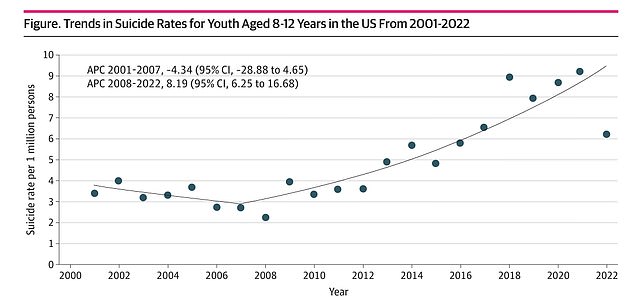Suicide rates among primary school-aged children have nearly doubled in the past 20 years, according to new research.
Researchers examined death records for U.S. preteens ages 8 to 12 from January 1, 2001, to December 31, 2022.
They found that the rate rose from about 3.3 per million deaths in 2001 to more than nine per million in 2021, an increase of more than 170 percent.
Research indicates that a prolonged and worsening mental health crisis among young people is leading to a rise in suicides. The crisis has led to record rates of hopelessness, depression and anxiety.
Using existing death record data, researchers found that suicide rates per million have increased at a rate of 1.7 per million over the past two decades.

The researchers did not explicitly explain why suicide rates among children are rising, but it coincides with a worsening mental health crisis among young people.
The overall number of suicide deaths remains low. A total of 2,241 preteens died by suicide between 2001 and 2022.
About 68 percent of them were children between eight and twelve years old.
Yet today suicide is the fifth most common form of death among children aged eight to twelve. In 2001, it wasn’t even in the top ten.
According to the latest research, hanging or suffocation was the predominant method of suicide over the two-decade period, but the biggest increase in preteen suicides was by firearm.
The researchers said: “This study provides a foundation for future research to explore unique factors associated with preadolescent suicide.”
Their findings were published in the journal JAMA Network Open.
Meanwhile, figures show that the percentage of those who have contemplated or attempted suicide is at an all-time high.
In 2011, 16 percent of young people considered suicide, a percentage that increased to 22 percent in 2021. In 2011, 8 percent attempted suicide, and in 2021, 10 percent attempted suicide.
Black preteens had the highest suicide rates in both periods, while Hispanic preteens had the largest percentage increase.
The researchers said: “These findings highlight the need to better understand suicide risk among racial and ethnic subgroups, including multiracial individuals who constitute the fastest growing racial group in the U.S.”
While researchers did not offer an explanation, government monitoring has consistently shown a worsening mental health crisis over the past two decades.
The sharpest rise in suicide rates coincided with the Covid pandemic, when millions of people were forced to forego social activities and time with friends, suffer disruptions to mental health care and be confined to their homes.
At the same time, federal researchers in an earlier report said: “As we saw in the 10 years preceding the COVID-19 pandemic, mental health among students overall continues to worsen.”
Experts across the medical and academic spectrum have postulated that various aspects of modern life have predisposed young people to mental distress.
An increasingly sedentary population with poor eating habits fuels feelings of depression and inadequacy. Research has shown that children who play sports are 20% less likely to suffer from depression than those who do not play sports. Being active is also linked to lower rates of anxiety.
Poor quality sleep also harms people’s mental health. Sleep research suggests that a teenager needs between eight and ten hours of sleep each night, although most teens only get between 6.5 and 7.5 hours of sleep per night.
Children are also more tied to screens and social media than ever before. Government researchers have found that children and teens who spend more than three hours a day on social media face double the risk mental health problems, including symptoms of depression and anxiety.
When asked about the impact of social media on their body image, 46 percent of teens ages 13 to 17 said social media makes them feel worse.


